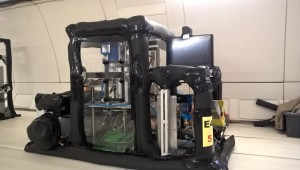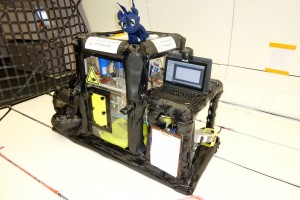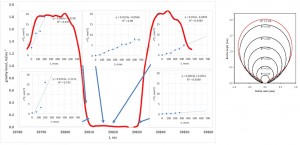Contact Person: I. Lioumbas [lioumbas@gmail.com]
The experimental apparatus installed on the plane just before the first sequence of Parabolas is presented in Figure 1. The experimental device is designed and constructed in such a way in order to investigate the influence of gravity on heat and mass transfer phenomena over and below the surface of different porous media (i.e. ceramic and metallic porous media, initially fully saturated with liquid & natural porous medium: potato) when this is immersed in hot oil. The hot liquid triggers boiling over the surface of the porous medium. This particular heating approach cancels the effect of natural convection in the surrounding liquid layers and circumvents the problem of non-uniform heating of the exposed porous surface.
Tests short description:Three different types of porous media were employed and are immersed in hot oil (130 oC).:
- ceramic porous material (average pore sizes 1.6 and 16 μm) saturated with tap water,
- metallic porous material
- potato
Temperature recordings (4Hz) at three distances right below the porous surface and simultaneous optical recordings of bubbles activity (100fps, window frame: 11×5.5mm) over and above the porous surface are combined to investigate the effect of gravity acceleration (from 1.8 to ~ 0 g earth) on the boiling process. For each type of ceramic porous material recordings are obtained continuously over a number of consecutive parabolas during all three phases of g variation: gearth – hypergravity- microgravity. Experiments were conducted on April 2016 during the 64th ESA Parabolic Flight Campaign and on May 2017 during the 66th ESA Parabolic Flight Campaign . To our knowledge this is the first time that boiling in porous substrates is examined at microgravity conditions.
Figure 2 reveals that during microgravity conditions the:
- Boiling process is not interrupted as new bubbles grow and detach continuously
- Bubbles size and population are affected significantly by gravitational conditions (i.e. bubble size increases and bubbles population decreases as gravitational acceleration decreases)
- Temperature gradients inside the porous materials are not affected by the bubble dynamics.
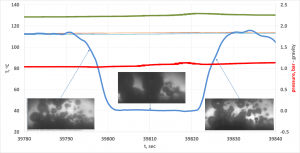
Figure 2: Bubble dynamics along with temperature measurements (green line: oil bulk, thin lines: below porous surface) and pressure measurements (red line) over a typical parabola (blue line: gravity level).
Detailed image analysis of several parabolas sequences will allow to quantify the dynamic effect of gravitational acceleration on bubbles: (a) size , (b) population, (c) generation frequency and (d) growth rate, and so to compare with literature data and models. Figure 3 demonstrates that the:
- Average bubbles radii agree with the predictions of an empirical equation developed during Phase I of this project (hypergravity experiments in LDC/ESTEC) if extrapolated to the current g values.
- Bubbles size increases whereas bubbles population and generation frequency decreases as gravitational acceleration decreases. The above imply that the steam production rate may not vary so much among different gravity levels.
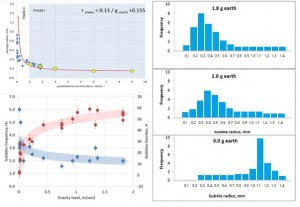
Figure 3: Effect of gravitational acceleration on bubbles size, bubbles number and frequency. The red line denotes the predictions by the empirical relation of Lioumbas and Karapantsios (2015) after hypergravity experiments (Phase I).
The continuous recording of bubble activity (Figure 4) manifests how bubble growth depends on gravity level. Further analysis of the data, will allow us to examine whether the theory developed for vapor bubbles growth can be successfully applied in the particular case of boiling in porous media
SYNOPSIS
For the first time it was seen that:
- Boiling continues regularly and systematically in every porous substrates tested even at microgravity conditions
- The examined two average pores sizes (1.6 and 16 µm) do not affect the boiling process
- The material of the porous material affects the boiling duration
There are indications that:
- The total production of vapor is not seriously affected (if at all; data analysis in progress) by gravity level.
- Bubble dynamics (size, population, generation frequency, growth) is affected by gravity level.
- Bubble production during microgravity may be due to intermittent local pressure increase inside the pores (due to the enormous density difference between liquid and vapor during phase change) leading to spontaneous steam ejection to outside of the pores and consequent pressure relief. Ongoing data analysis will confirm or decline the above speculation.
Typical Experiment during a Parabola: Video Link Link
